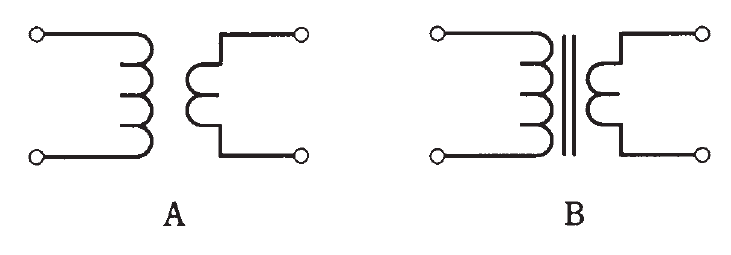


 الفيزياء الكلاسيكية
الفيزياء الكلاسيكية
 الكهربائية والمغناطيسية
الكهربائية والمغناطيسية
 علم البصريات
علم البصريات
 الفيزياء الحديثة
الفيزياء الحديثة
 النظرية النسبية
النظرية النسبية
 الفيزياء النووية
الفيزياء النووية
 فيزياء الحالة الصلبة
فيزياء الحالة الصلبة
 الليزر
الليزر
 علم الفلك
علم الفلك
 المجموعة الشمسية
المجموعة الشمسية
 الطاقة البديلة
الطاقة البديلة
 الفيزياء والعلوم الأخرى
الفيزياء والعلوم الأخرى
 مواضيع عامة في الفيزياء
مواضيع عامة في الفيزياء|
Read More
Date: 5-5-2021
Date: 18-4-2021
Date: 1-4-2021
|
Transformer cores
If a ferromagnetic substance such as iron, powdered iron, or ferrite is placed within the pair of coils, the extent of coupling is increased far above that possible with an air core. But this improvement in coupling takes place with a price; some energy is invariably lost as heat in the core. Also, ferromagnetic transformer cores limit the frequency at which the transformer will work well.
The schematic symbol for an air-core transformer consists of two inductor symbols back-to-back (Fig. 1A). If a ferromagnetic core is used, two parallel lines are added to the schematic symbol (Fig. 1B).

Fig. 1: Schematic symbols for air-core (A) and ferromagnetic-core (B) transformers.
Laminated iron
In transformers for 60-Hz utility ac, and also at low audio frequencies, sheets of silicon steel, glued together in layers, are often employed as transformer cores. The silicon steel is sometimes called transformer iron, or simply iron.
The reason layering is used, rather than making the core from a single mass of metal, is that the magnetic fields from the coils cause currents to flow in a solid core. These eddy currents go in circles, heating up the core and wasting energy that would otherwise be transferred from the primary to the secondary. Eddy currents are choked off by breaking up the core into layers, so that currents cannot flow very well in circles.
Another type of loss, called hysteresis loss, occurs in any ferromagnetic transformer core. Hysteresis is the tendency for a core material to be “sluggish” in accepting a fluctuating magnetic field. Laminated cores exhibit high hysteresis loss above audio frequencies, and are therefore not good above a few kilohertz.
Ferrite and powdered iron
At frequencies up to several megahertz, ferrite works well for radio-frequency (RF) transformers. This material has high permeability and concentrates the flux efficiently. High permeability reduces the number of turns needed in the coils. But at frequencies higher than a few megahertz, ferrite begins to show loss, and is no longer effective.
For work well into the very-high-frequency (VHF) range, or up to 100 MHz or more, powdered iron cores work well. The permeability of powdered iron is less than that of ferrite, but at high frequencies, it is not necessary to have high magnetic permeability. In fact, at radio frequencies above a few megahertz, air core coils are often preferred, especially in transmitting amplifiers. At frequencies above several hundred megahertz, ferromagnetic cores can be dispensed with entirely.



|
|
|
|
"إنقاص الوزن".. مشروب تقليدي قد يتفوق على حقن "أوزيمبيك"
|
|
|
|
|
|
|
الصين تحقق اختراقا بطائرة مسيرة مزودة بالذكاء الاصطناعي
|
|
|
|
|
|
|
قسم شؤون المعارف ووفد من جامعة البصرة يبحثان سبل تعزيز التعاون المشترك
|
|
|